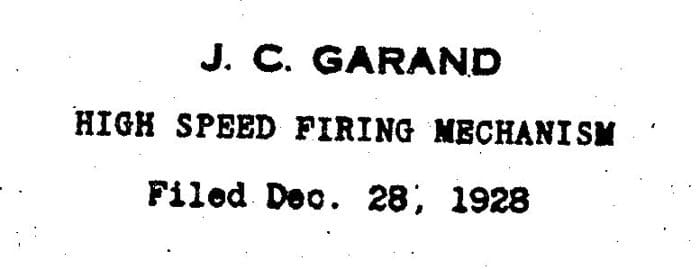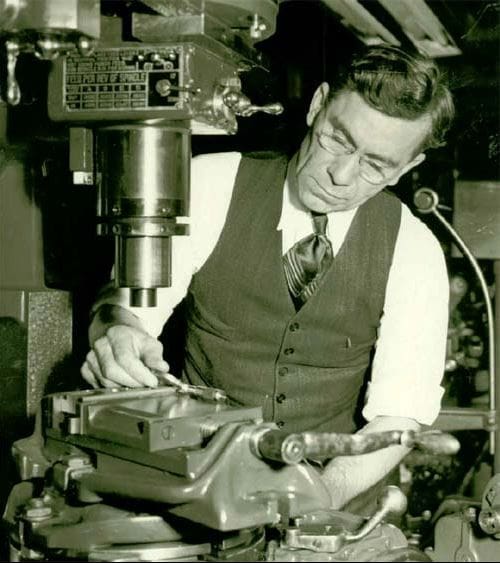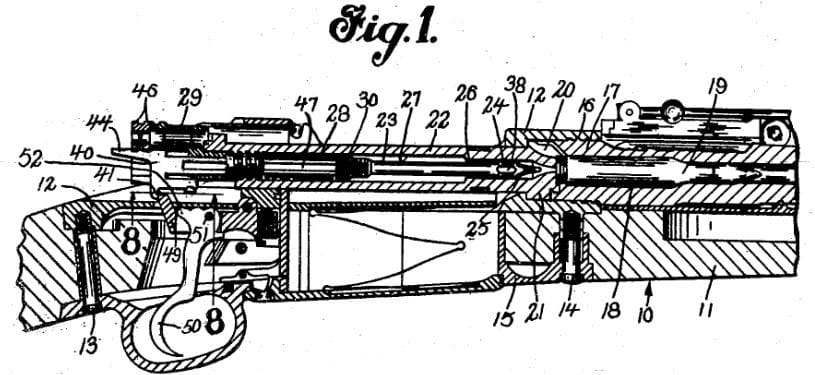In the waning days of 1928, John C. Garand filed a patent application for a “High Speed Firing Mechanism.” At the same time, he was working diligently at Springfield Armory in Massachusetts, developing the rifle that would soon bear his name.

The patent, which was granted in November 1930 and assigned to the Lyman Gun Sight Corporation, was for a change in the firing pin and spring design for the M1903 bolt-action rifle.
The firing pin was to be modified to accept a “relatively stiff spring” made of chrome-vanadium wire that was to have a keystone shape when viewed from a cross-section. When the wire was wound into a spring, the coils would compress and change shape to a square because of the pressure exerted upon it. The now-square shape meant that each of the spring’s coils would be in full and direct contact with one another.

Modifications to the firing pin included flattened sides for less contact friction with the bolt and less overall weight. This would result in a faster fall time of the firing pin, which would give the shooter less time to inadvertently move the rifle off target once the trigger was pulled.
Generally speaking, less time to pull off target is a good thing, but this is where Garand really got down into the minutiae of things.
He measured the average fall time of an unaltered M1903 to be 0.0057 seconds. His new design would reduce the fall time to 0.0022 seconds, which is a full 3.5 milliseconds faster. For reference, it takes the average person 0.0300 seconds to blink. That makes it highly unlikely – or, hell, I just go ahead and say it: impossible – for anyone to perceive the acceleration in firing speed from Garand’s new design.

It should come as no surprise that his High Speed Firing Mechanism didn’t catch on. There are no known records of the military performing any field tests with it and there’s certainly no indication that they ever even came close to adopting Garand’s new design. That’s probably a good thing, too, because if it had, who knows what kind of other crazy stuff he might have come up with! Instead, he kept working on another, more practical design for a semi-automatic rifle.
(Thanks to Corey Wardrop of the Institute of Military Technology for bringing this patent to my attention.)
Logan Metesh is a firearms historian and consultant who runs High Caliber History LLC. Click here for a free 3-page download with tips about caring for your antique and collectible firearms.





In the Book “Band of Brothers”, Dick Winters had his M1 Garand modified to be Fully Automatic by Corporal Forrest L. “Goody” Guth…
I witnessed a full automatic (inadvertent) M1 Garand fire at a firing range.
USMC, firing for qualification.
I was behind the three or four feet to the side of the Marine when he reloaded with a full clip. Each round of fire was ten shots. Started with a clip and two rounds loaded. Fire two rounds, reload with full eight round clip and fire next eight. He fired one round in the full clip. Pulled the trigger on the next shot and it fired four or five rounds so fast you could not distinguish individual shots. It jammed and ended the volley.
I pulled him off the line and removed the trigger housing group. By that time the range officer, and several senior NCOs had gathered around.
The sear was “stuck” in the unlock position. We determined that sand had somehow gotten in the mechanism. My guess was the sand was in the clip he had just loaded but we could not prove it. He was punished for a dirty rifle and had to redo his qualification shoot.
Point being, It is easy to “convert an M1 to full automatic” but it is uncontrolled rate and jams. It would be possible but more difficult to convert to controlled automatic so it would be reliable.
In the deep dark past I was a Marine Marksmanship Instructor, among other interesting jobs.
Do you a guy named Vince A. From NYC?
Do you mean that jerk-off Vincent D’Onofrio, from ‘Full Metal Jacket’?
The cyclical rate on a Garand is really high even in stock form. Around 1000rpms IIRC. A bit lower bolt travel rate would both reduce recoil and also reduce wear. I’ve accidently doubled mine a couple of times. I can’t imagine trying one on full auto. You’d be lucky to get all 8 rounds in to the same hillside.
Very cool. The “Book of the Garand” is also a great read for more on John C Garand.
“He measured the average fall time of an unaltered M1903 to be 0.0057 seconds. His new design would reduce the fall time to 0.0022 seconds, which is a full 35 milliseconds faster.”
Um… no. The difference between 0.0057 and 0.0022 is 0.0035, or 3.5 milliseconds.
When milliseconds count, the decimal point is only three digits away.
Thanks for catching that!
That ‘full 3.5 milliseconds faster’ might not look like much, but Garand managed to shave off 61.4 percent of the fall time. Making already fast acting mechanism work almost two thirds faster is nothing to sneeze at.
Is it worth the effort? That’s different question. But I can’t see how it can be a bad thing.
As a side note – another positive effect of sqared striker’s sides is that it creates channels for air to escape.
Competition benchrest shooters might benefit from the idea. Don’t know that it would really matter for most others.
Garand was certainly a genius grade individual..
I was kind of hoping for a cartridge driven sewing machine, something in .30 caliber creedmoor
Banning bump stocks will make Garand’s “high speed firing mechanism” illegal.
you guys are all pronouncing garand incorrectly.
It’s LeviOHsa not levioSAH.
英国代写 12
Comments are closed.